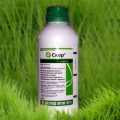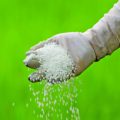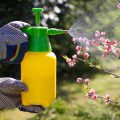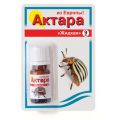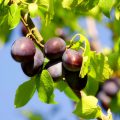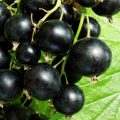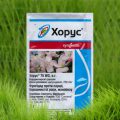Caterpillars on gooseberries - a common phenomenon, with which the spring facing gardeners and horticulturists. After a winter of hungry caterpillars in search of food start to attack plants, damaging trees and shrubs. As a result of the defeat of the stems and leaves of gooseberry significantly reduced the number of crops. It is therefore important to know the, than the process of gooseberries caterpillars, to the bush remained healthy.
pest species
Aphids gooseberry sprout
Pest gooseberry and currant aphid refers sprout. It is a small sucking insect green, whose length is 1,1-1,9 mm. In winter, the eggs of aphids located on the shoots near the kidneys. In April, the larvae hatch and begin to suck the juice out of them. When the buds bloom, pests move on petioles of young leaves and green shoots of gooseberry. Gardener can easily detect insects, since there are processes of twisted clumps of leaves. Inside them to proliferate aphid.
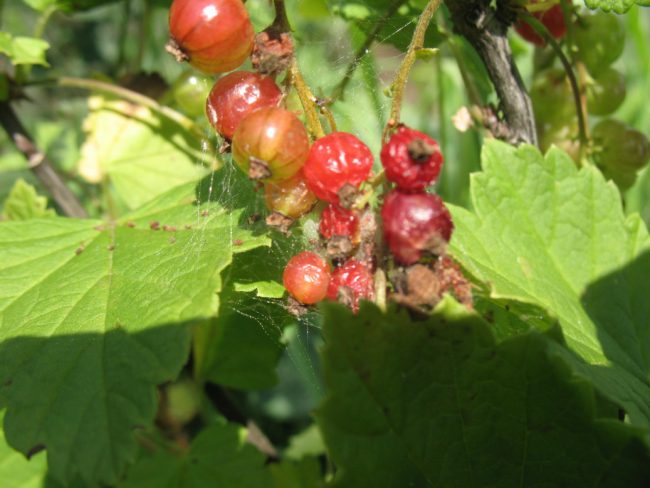
By the beginning of the summer colony of aphids can attack the whole garden. Often they travel long distances. Pest control is complicated by its rapid reproduction. During the season the female can reproduce several generations. Peak defeat shrubs occurs in May and June.
Control measures
To protect gooseberry aphid, should carry out such recommendations:
- In the autumn necessary to carry out land tillage under the plants at a depth of 10 to 15 cm.
- Irrigate gooseberries and currants with a soap solution. enough to dissolve 350 g grated economic or tar soap in a bucket of water.
- To eliminate insect eggs must early spring to spray hot water or shrub 3% Nitrafenom.
- Effectively used for the treatment insecticide plant. The most popular are Decis, Fufanon, able to, Hostakvik and Karbofos.
- Spray before flowering shrubs or drug trichlorfon phosalone. It is useful to carry out the processing of gooseberry Entobakterinom Trihlormetafosom or after flowering.
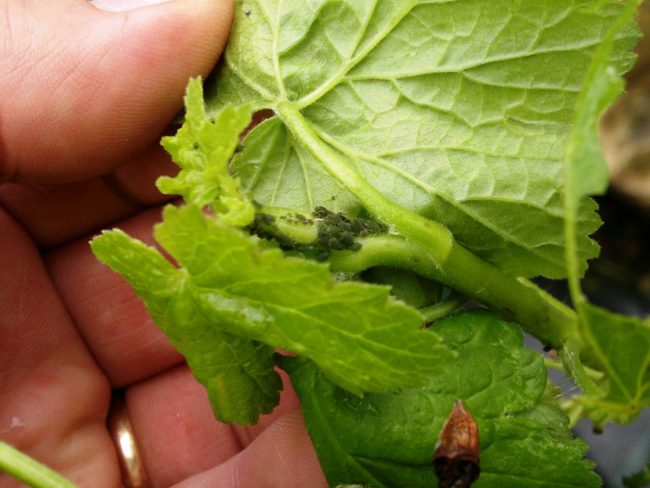
You can get rid of aphids by removing the top of the sprouts, which were twisted leaves.
Important! processing plants of any drug should be in the evening in the dry weather. Aase attention should be paid to the leaves on the lower side, which often accumulates aphid.
Before flowering and after harvest is useful to apply Anometrin H and Antitlin. Worked well in the fight against aphids ecologically pure preparation Fitoverm.
After flowering, you can deal with aphids folk remedies:
- The leaves of lilac. Would need 1 kg of dried inflorescences and 6 liters of water. Leave the mixture on 3 o'clock, then in a water bath protomai 40 minutes and strain. Ready solution to 24 hours put in a dark place. Before processing plant it is necessary to add 30 g grated soap.
- Plant tomatoes. It has a deterrent effect. It is necessary to sit down between the rows.
- elderberry extract. To prepare the infusion should be taken 100 g of dried flower clusters and connect with 1 liters of water. Insist 1 day. Means to bring 10 l, also adding to it 30 g Soap.
- Garlic. grind 4-5 cloves and pour 1 liters of water. Mix thoroughly, and to insist 5 days. The dosage of garlic tincture is 25 ml of 10 liters of water.
- Onion. join 250 g minced with onion 10 liters of water. Insist 24 o'clock, then conduct processing.
- wood ash. Add 3 glass raw material into a bucket of cold water. Insist 24 o'clock, whereupon the mixture was warmed to 70 °C. Add in the 40 g soap.
- Infusion of yarrow. join 800 g of crushed dry raw material and 10 liters of water. leave on 3 day.
- Tobacco. should take 350 g chopped tobacco leaves or tobacco dust and fill a bucket of water. Insist 2 day, after which the filter. Add more 10 l of water and 100 g soap.
Yellow gooseberry sawfly
Dangerous pest of gooseberries, red and white currant is yellow gooseberry sawfly. Its caterpillars are able to consume the leaves of the plant up to the veins. In winter, the larvae are grown in soil in cocoons. insect body length does not exceed 8 mm. The most dangerous species of pest specialists include yellow and blednonogo sawfly.
The first generation of insect damages the red currants, because its buds bloom earlier gooseberry. The second generation of striking and gooseberries can go to black currants. The third generation of fully captures the gooseberry bushes.

Sawfly caterpillars damage the lamina, they appear small holes eaten away. Then they eat the pests completely. The most dangerous for the bush is considered a second generation of larvae sawfly, because a large number of them are able to destroy all of the leaves 7-14 days. Also, when these insects lesions appear small berries, some of which fall prematurely.
Control measures
To save the gooseberry and currant sawfly caterpillars of a few rules must be followed:
- During bud break ground cover under shrubs film and loosen at depth 10 cm, then make under every bush on 200 ash, 25 g of pepper and dry mustard.
- Spray the bushes infusion of wormwood. For its preparation must take 5 kg of ground blossoming and pour wormwood 10 liters of water. Leave a means to 24 o'clock, then boiled for half an hour, cool, drain and add to water in a ratio of 1:1.
- During the budding process plants 10% solution of malathion. To this should be diluted 75 g means in a bucket of water.

Malathion can not be used during the flowering fruit trees and ornamental plants, not to kill bees - Use biologics Dendrobatsillin, and Lepidocid.
- Processing chemicals Decis bushes or Intal Vir.
- After spray the plants flowering tobacco extract or wood ash with the addition of 45 g of soap per bucket of water.
- Dig the soil under the bushes in the autumn.
- Between bushes to plant tansy to repel pests. enough 1 plants on 6-7 bushes.
bud moth
Moth or Vertunov bud is a pest of cherries, apple trees, pears, quince and currants. It has a thick body, hairy. The length is not more than 2 cm.
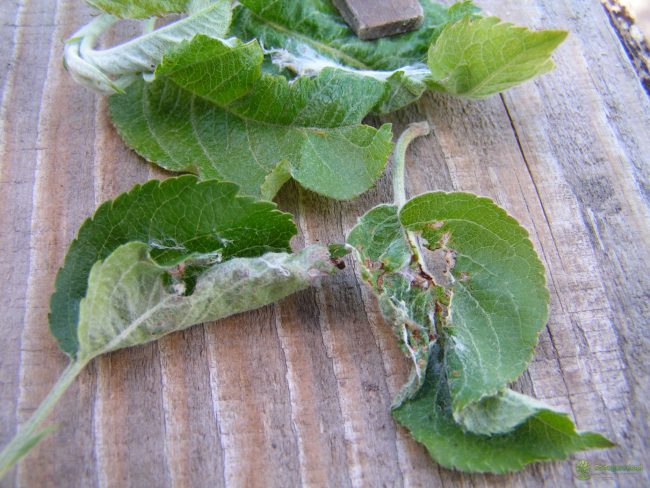
Currant leaf female can lay up 150 eggs. caterpillars, hatched from them, gnaw the leaves and twisted them. With a high number of leaf-harvest may decline by 75-80%.
Control measures
To save the currant bushes on leaf, you must perform the following recommendations:
- Processing plant to bloom insecticides. The air temperature should be at least + 10 ° C.
- During the swelling of the buds to be used for spraying drugs aktellik, Kemifos and Fufanon. Reprocessing should be performed 2-3 weeks after flowering.
- Spray the bushes infusion on the basis of tobacco powder. To this should be added 500 g feed in a bucket of water and leave for 48 hours. Then filter and boil on low heat for 2 hours. Received means diluted with water in a ratio of 1:1 and for every 10 l solution add 60 g Soap. Use the mixture should be immediately. Processing is performed in gloves, as a means of poisonous.
- Help protect the plant tomato tops. To do this, 5 kg tops or roots joined to 10 liters of water. after 3 hour supply capacity on low heat and simmer for half an hour. After that, as a means to cool, strain. Then be diluted with water in a ratio of 1:1 and add 45 g soap.
- Save bushes from the invasion of potato leaf-tops. Enough finely chopped 5 kg fresh haulm, put in a bucket and add water. Through 4 hour filter medium and add 45 g soap.
gooseberry padyanitsa
It is a butterfly, that harms gooseberries and currants. Larvae can reach up to 40 mm in length. They overwinter in cocoons under the fallen leaves. In early spring they destroy the buds and leaves. Female gooseberry padyanitsy at a time may be postponed until 300 eggs. Their development lasts 1,5 to 3 weeks. Caterpillars feed on the underside of the young leaves.
Control measures
To destroy the caterpillars or preventing destruction of gooseberry and currant bushes important to know and do the following:
- Regularly collect and destroy fallen leaves.
- Loosen the earth under the bushes in the winter to get rid of larvae in the soil.
- Processing plant infusions tansy, wormwood, chamomile or tobacco.
- Spray the bushes with a solution malathion 2 fold. The first treatment should be done in early spring, and the second - in the summer.
- Between bud recommended chemical preparation Kinmiks.
- Before flowering, you can use these drugs, how Iskra, aktellik, Inta-Vir or Kemifos.
- Treat shrubs biologics - or Fitoverm Lepidocide.
gooseberry moth
Gooseberry moth - a moth, It is affecting not only the gooseberry, but also currants and raspberries. Its pupa overwinter in the soil under the bushes in a cocoon of cobwebs. Early in the spring begins to age butterflies. This period often coincides with the blooming flowers. One butterfly is able to defer 150-200 eggs. When mass numbers of caterpillars entangle cobwebs berries, forming large clumps. Damaged fruit rot and begin to dry up, so many gardeners moth called the gooseberry moth.
Control measures
To combat the pest can be at different stages of life moth:
- If an insect is on the bushes of gooseberry or currant, it is necessary to collect all the affected berries and caterpillars, then destroy them.
- After the fall of the leaves in autumn dig up the soil and shrubs okuchit.
- Spray plants with pesticides before and after flowering. For this fit Malathion. Dosage money for a bucket of water is 5 g. For effective means also include Spark, Inta-Vir, Kemifos and Fufanon.
- Processing of wood ash. should take 3 kg of raw material, Sift and dissolve in 10 liters of water. Received means insist 2 day, then filter and to perform the procedure.
- Tincture based on mustard. dilute 100 g dry mustard in a bucket of water and leave 2 day. Then strain and dilute at a ratio of 1:2.
- Treatment 12% solution of dust. Dostum is necessary to process the soil around the bushes. Through 7 days to scatter it in the amount of 50 g for pinning effect.
- The infusion of the tops of tomatoes. Spraying is carried out every 7 days.
- conifer branch. should be mixed 250 r branches with 2 l of warm water in a ratio of 1:10.



